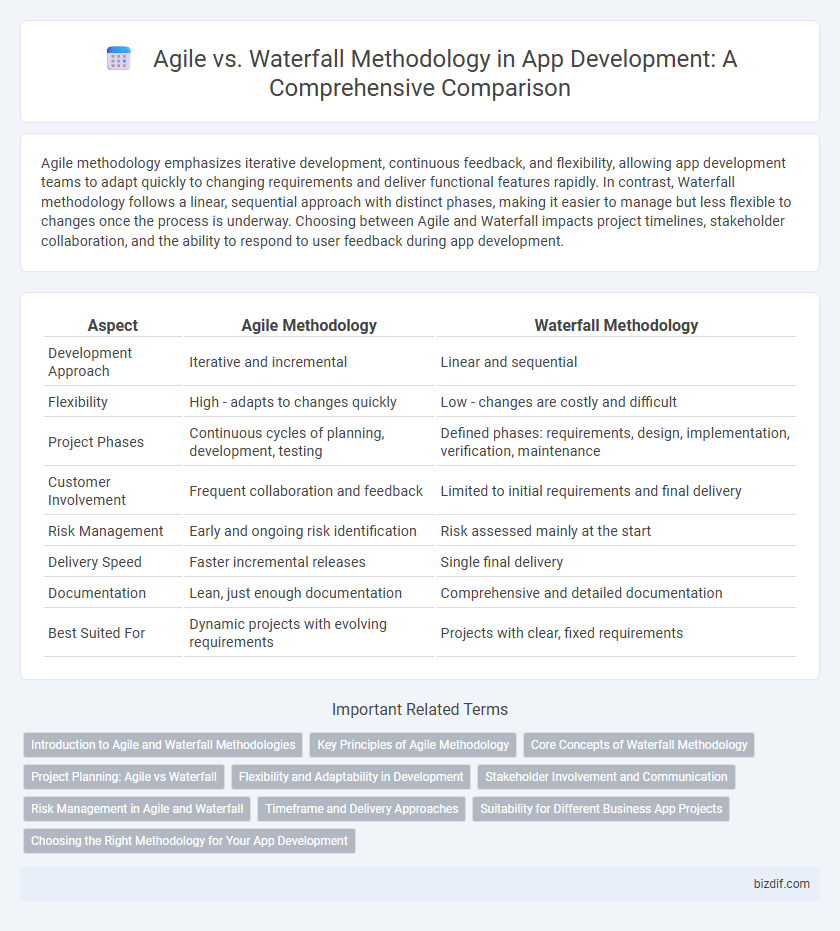Agile methodology emphasizes iterative development, continuous feedback, and flexibility, allowing app development teams to adapt quickly to changing requirements and deliver functional features rapidly. In contrast, Waterfall methodology follows a linear, sequential approach with distinct phases, making it easier to manage but less flexible to changes once the process is underway. Choosing between Agile and Waterfall impacts project timelines, stakeholder collaboration, and the ability to respond to user feedback during app development.
Table of Comparison
| Aspect | Agile Methodology | Waterfall Methodology |
|---|---|---|
| Development Approach | Iterative and incremental | Linear and sequential |
| Flexibility | High - adapts to changes quickly | Low - changes are costly and difficult |
| Project Phases | Continuous cycles of planning, development, testing | Defined phases: requirements, design, implementation, verification, maintenance |
| Customer Involvement | Frequent collaboration and feedback | Limited to initial requirements and final delivery |
| Risk Management | Early and ongoing risk identification | Risk assessed mainly at the start |
| Delivery Speed | Faster incremental releases | Single final delivery |
| Documentation | Lean, just enough documentation | Comprehensive and detailed documentation |
| Best Suited For | Dynamic projects with evolving requirements | Projects with clear, fixed requirements |
Introduction to Agile and Waterfall Methodologies
Agile methodology emphasizes iterative development, collaboration, and flexibility, allowing app development teams to adapt quickly to changing requirements and deliver functional software incrementally. Waterfall methodology follows a linear, sequential approach where each phase--requirements gathering, design, implementation, testing, and deployment--is completed before moving to the next, making it suitable for projects with well-defined specifications. Both methodologies influence project management styles and impact app development efficiency, risk management, and stakeholder communication.
Key Principles of Agile Methodology
Agile methodology in app development emphasizes iterative progress, customer collaboration, and adaptive planning to respond swiftly to changing requirements. It promotes cross-functional teams working in short sprints to deliver incremental value and continuous feedback incorporation. Unlike the linear Waterfall approach, Agile fosters flexibility, early testing, and frequent releases to enhance software quality and stakeholder satisfaction.
Core Concepts of Waterfall Methodology
Waterfall Methodology in app development follows a linear, sequential approach where each phase, such as requirements gathering, design, implementation, testing, and deployment, is completed before moving to the next. This rigid structure emphasizes comprehensive documentation and strict adherence to initial requirements, minimizing changes during the development process. Waterfall's core concept ensures predictability and clear milestones but lacks the flexibility to accommodate evolving client needs.
Project Planning: Agile vs Waterfall
Agile methodology embraces iterative project planning, allowing teams to adapt to changing requirements through continuous feedback and incremental delivery. Waterfall methodology relies on a linear, sequential project plan with fixed phases, emphasizing upfront requirement definition and strict milestones. Agile enables flexibility and faster issue resolution, while Waterfall provides clear timelines and structured documentation for project scope and deliverables.
Flexibility and Adaptability in Development
Agile methodology offers high flexibility and adaptability by enabling iterative development and frequent feedback loops, allowing teams to respond quickly to changing requirements during app development. In contrast, Waterfall methodology follows a linear and rigid process with predefined phases, limiting the ability to accommodate changes once the project scope is set. Agile's dynamic approach fosters continuous improvement and faster delivery, making it more suitable for projects where requirements evolve frequently.
Stakeholder Involvement and Communication
Agile methodology promotes continuous stakeholder involvement through regular sprint reviews and daily stand-ups, ensuring transparent and real-time communication that adapts to evolving project requirements. Waterfall methodology relies on predefined phases with limited stakeholder interaction, often leading to communication gaps and delayed feedback until project milestones are completed. Prioritizing Agile's iterative engagement improves project alignment, responsiveness, and stakeholder satisfaction in app development.
Risk Management in Agile and Waterfall
Agile methodology excels in risk management by promoting iterative development, continuous feedback, and early detection of issues, reducing the likelihood of project failures. In contrast, Waterfall methodology manages risks through detailed upfront planning and sequential phases, which can delay the identification and resolution of problems until later stages. The adaptive nature of Agile allows for more flexible responses to changing requirements, minimizing risks associated with scope creep and market shifts.
Timeframe and Delivery Approaches
Agile methodology emphasizes iterative development with flexible timeframes, enabling frequent deliveries and continuous client feedback throughout the app development cycle. Waterfall methodology follows a linear, sequential approach with fixed phases and a predetermined timeframe, resulting in a single final delivery after all stages are completed. Agile's adaptability shortens time to market, while Waterfall is suited for projects with well-defined requirements and deadlines.
Suitability for Different Business App Projects
Agile methodology excels in dynamic business app projects requiring frequent updates, iterative development, and close collaboration between cross-functional teams, making it ideal for startups and evolving market demands. Waterfall methodology suits well-defined projects with fixed requirements, strict deadlines, and regulatory constraints, such as enterprise resource planning (ERP) systems or healthcare applications. Choosing the right approach depends on project complexity, flexibility needs, and stakeholder involvement to ensure timely delivery and quality outcomes.
Choosing the Right Methodology for Your App Development
Selecting the appropriate methodology for app development hinges on project scope, flexibility needs, and stakeholder involvement. Agile methodology offers iterative progress, adaptability to changes, and continuous user feedback, ideal for complex or evolving app projects. Waterfall methodology provides a linear, structured approach suited for projects with well-defined requirements and fixed timelines.
Agile Methodology vs Waterfall Methodology Infographic

 bizdif.com
bizdif.com